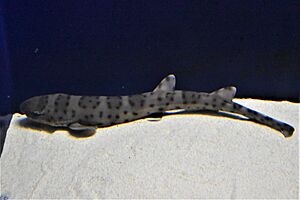Bali catshark facts for kids
Quick facts for kids Bali catshark |
|
|---|---|
 |
|
| Conservation status | |
| Scientific classification | |
| Genus: |
Atelomycterus
|
| Species: |
baliensis
|
The Bali catshark (Atelomycterus baliensis) is a type of catshark. It belongs to the family of sharks called Scyliorhinidae. You can only find this shark near the Indonesian island of Bali. It can grow to about 47 centimeters (18.5 inches) long. The Bali catshark lives in the deep coastal waters around Bali. It hunts and eats small fish and other tiny sea creatures.
Contents
What Does the Bali Catshark Look Like?
The Bali catshark has special colors that make it stand out. Most catsharks have clear white spots on their bodies. But the Bali catshark does not have these spots.
Its back has four dark "saddles." These look like four brown patches across its body. Also, the tips of its dorsal fins (the fins on its back) do not have any bright highlights. These unique markings help scientists tell the Bali catshark apart from other catshark species.
How Do Bali Catsharks Have Babies?
We don't know a lot about how Bali catsharks reproduce. But like most other catsharks, they are likely oviparous. This means the mother lays eggs, and the babies develop outside her body.
Bali catshark mothers lay their eggs in special cases. They often choose sandy areas or rocky spots to lay these egg cases.
Bali Catshark Egg Cases
The egg cases of the Bali catshark are similar to those of other Atelomycterus species. This group includes six different types of catsharks.
The egg cases are wider in the middle and get narrower at both ends. The front end is a bit blunt. It might have fibers that help attach the egg case to something in the ocean. This keeps it safe while the baby shark grows inside. The back end is more pointed and has two horn-like parts. Unlike some other catshark species, the Bali catshark's egg cases do not have curled tendrils on these horns.
Each egg case has four small openings, one on each corner. These openings allow water to flow through, helping the baby shark breathe. The width of the egg case sides can also help tell different species apart. The Bali catshark's egg case has a wider middle section that tapers down at both ends.
Images for kids



